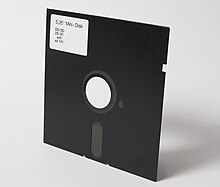Floppy disk punch
A disk punch is a small piece of equipment that punches a rectangular notch in the edge of a 5¼-inch diskette . This was necessary in order to be able to use the second side on some home computers such as the Commodore 64 or the Apple II , whose usual floppy disk drives were equipped with only one read / write head for the bottom.
When shipped from the factory, 5¼-inch floppy disks usually only had one notch on the right-hand side that could be used by a light barrier or mechanical switch in the floppy disk drive. If the light barrier was interrupted because there was no notch (for example on some original diskettes from games and operating systems) or it was covered with an opaque adhesive tape, the medium was write-protected.
If the second side of a double-sided diskette was to be formatted in a floppy disk drive like the VC1541, you first had to punch holes on the left side so that it could be written to at all, and then insert it into the drive with the label facing down.
The trick does not work with floppy disk drives for PCs because they use an additional light barrier to find the beginning of the track to query the index hole (to the right of the drive hole on the floppy disk), which is covered after the floppy disk has been turned. The later 1570 and 1571 drives from Commodore also used the index hole for the optionally supported CP / M / DOS -formatted floppy disks. The home computer drives dispensed with this index light barrier for cost reasons and instead applied a special short data block (SYNC) at one point on each track to mark the beginning of the track. There were, however, also floppy disks with two recesses for the index hole so that the disk could be turned over again.
Another requirement for using both sides of the disk was that the disk had a magnetic coating on the back as well . This was the case with many single-sided disks, so that cheap single-sided disks could be used on both sides with a second notch. Alternatively, the necessary notch was made on the floppy disk using a conventional paper punch or scissors; however, you risked damage to the disk and the result was less attractive.
The disk punch, which was soon launched in response to this need, has a stop that allows correct positioning and a cutter that is strong enough to cut into the shell without kinking the disk.
An alternative to the floppy disk punch was to electrically bypass the write protection sensor built into the floppy disk drive. Such a modification of the drive made it possible to write on the back of the disk without having to punch holes, but it also prevented the disk from being effectively write-protected. Conversion instructions for this appeared again and again in various computer magazines, e.g. B. for the floppy drive VC1541 .
With the extinction of the 8-bit home computer, the 5¼-inch drives with only one read / write head disappeared from the market, along with the disk punches.


